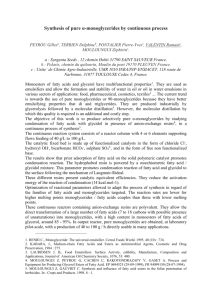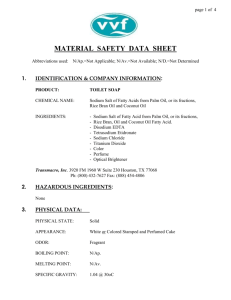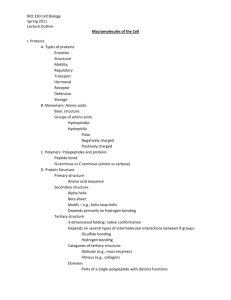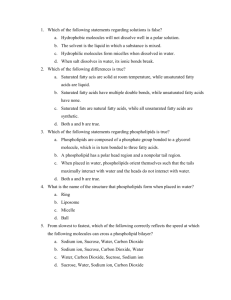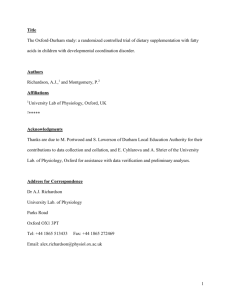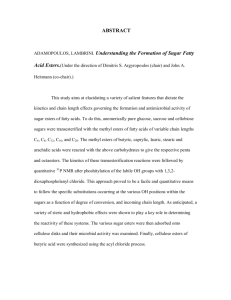Reduced symptoms of inattention after dietary omega
advertisement
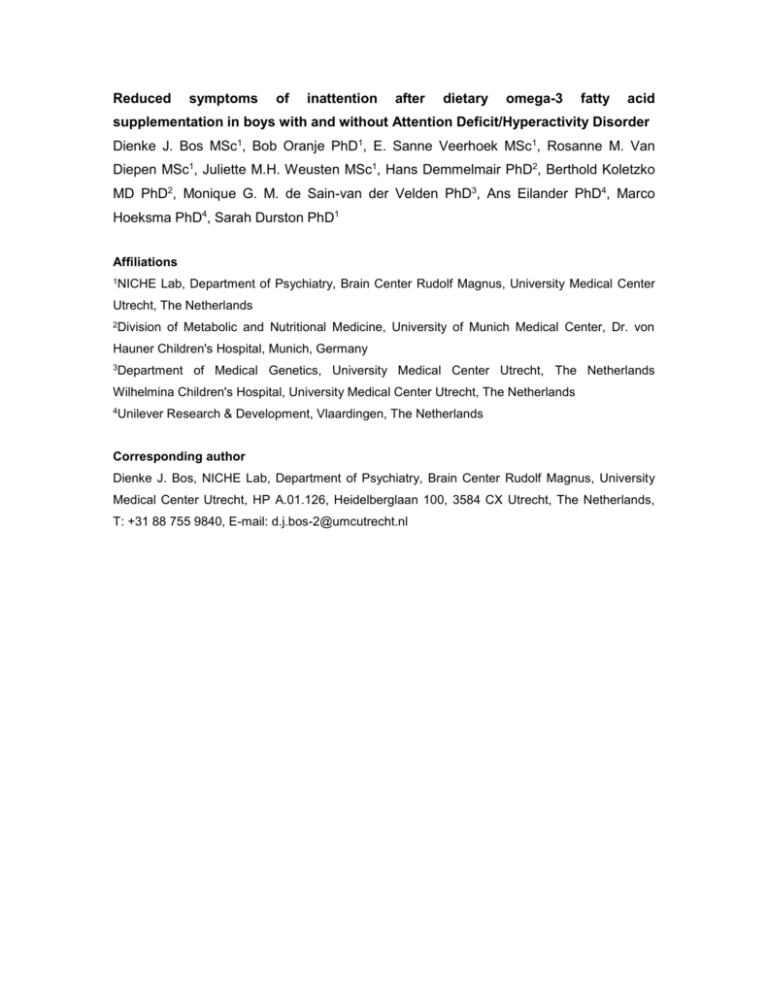
Reduced symptoms of inattention after dietary omega-3 fatty acid supplementation in boys with and without Attention Deficit/Hyperactivity Disorder Dienke J. Bos MSc1, Bob Oranje PhD1, E. Sanne Veerhoek MSc1, Rosanne M. Van Diepen MSc1, Juliette M.H. Weusten MSc1, Hans Demmelmair PhD2, Berthold Koletzko MD PhD2, Monique G. M. de Sain-van der Velden PhD3, Ans Eilander PhD4, Marco Hoeksma PhD4, Sarah Durston PhD1 Affiliations 1NICHE Lab, Department of Psychiatry, Brain Center Rudolf Magnus, University Medical Center Utrecht, The Netherlands 2Division of Metabolic and Nutritional Medicine, University of Munich Medical Center, Dr. von Hauner Children's Hospital, Munich, Germany 3Department of Medical Genetics, University Medical Center Utrecht, The Netherlands Wilhelmina Children's Hospital, University Medical Center Utrecht, The Netherlands 4Unilever Research & Development, Vlaardingen, The Netherlands Corresponding author Dienke J. Bos, NICHE Lab, Department of Psychiatry, Brain Center Rudolf Magnus, University Medical Center Utrecht, HP A.01.126, Heidelberglaan 100, 3584 CX Utrecht, The Netherlands, T: +31 88 755 9840, E-mail: d.j.bos-2@umcutrecht.nl Supplemental Material 1: Composition of the intervention product and analysis of the physiological measures. Nutrient composition of the intervention product All children received a daily 10-gram serving of the active- or placebo intervention product. In the placebo product EPA and DHA were replaced by mono-unsaturated fatty acids (MUFA); total saturated fatty acid (SAFA) and omega-6 fatty acid content were matched. Omega-6 fatty acids are also polyunsaturated fatty acids (PUFA), however these do not have the currently theorized and investigated properties of omega-3 fatty acids. Vitamin E content corresponded to the amount of PUFA present in the active or placebo product (Table S1). The active and placebo product had highly similar sensory properties, to prevent possible deblinding by the intervention product itself. Analysis of the Physiological Measures Lipid extracts were analysed as previously described (Koletzko et al, 1999), at the Dr. von Haunersches Kinderspital, Division of Metabolic Disorders and Nutrition, Munich, Germany. Briefly, the extract was dissolved in chloroform-methanol and phospholipids were isolated by thin layer chromatography. The phospholipid fraction was transferred into a glass vial for synthesis of fatty acid methyl esters by reaction with 3 M methanolic hydrochloric acid at 85°C for 45 minutes. The fatty acid methyl esters were extracted twice into hexane (Merck), the combined extracts were taken to dryness under a stream of nitrogen, and dissolved in 50 µl hexane containing 2 g/l butylhydroxytoluol as an antioxidant for storage until gas-chromatography. Gas chromatography was performed with an Agilent 7890 GC (Agilent, Waldbronn, Germany) equipped with a split/splitless injector, a BPX-70 column (50m, 0.25 mm inner diameter), and flame ionization detector. For identification and response quantification of individual fatty acid methyl esters external calibration was applied using a mixture of fatty acid methyl esters in hexane (NuCheck Prep., Elysian, USA). Identification-analyses of organic acids in urine were carried out by gas chromatography–mass spectrometry (GC–MS) (Agilent), at the University Medical Center Utrecht. Prior to this GC–MS analysis, the organic acids were extracted with ethylacetate and then trimethylsilylated at 60 °C for 30 min with N,N- bis(trimethylsilyl)trifluoracetamide-/pyridine/trimethylchlorosilane (5:1:0.05 v/v/v). The gas chromatographic separation was performed on a 25 m X 0.25 mm capillary CP Sil 19CB column (film thickness 0.19 mm) from Varian/Chrompack, Middelburg, The Netherlands. References Koletzko B, Knoppke B, Schenck U von, Demmelmair H, Damli A (1999). Noninvasive Assessment of Essential Fatty Acid Status in Preterm Infants by Buccal Mucosal Cell Phospholipid Analysis. J Pediatr Gastroenterol Nutr 29: 467–474. Table S1: Composition of the intervention product. Active test product Placebo product 72 72 FA Content MUFA (g) SAFA (g) PUFA (g) Trans FA (g) 2.08 2.66 2.66 0.1 4.32 2.59 1.05 0.04 Total n-3 FA (g) EPA (g) DHA (g) 1.48 0.65 0.65 0.06 - 0.07 0.06 Total n-6 FA (g) LA (g) GLA (g) DGLA (g) AA (g) 1.03 1.0 0.03 1.0 1.0 - Other Vitamin E (mg) Protein (g) 6.4 <1 0.52 <1 Energy (kcal) ALA (g) Abbreviations: kcal = kilocalory, MUFA = monounsaturated fatty acids, SAFA = saturated fatty acids, PUFA = polyunsaturated fatty acids, EPA = eicosapentaenoic acid, DHA = docosahexaenoic aicd, ALA =a-Linolenic acid, LA = Linoleic Acid, GLA = Gammalinolenic Acid, DGLA = Dihomo-gamma-linolenic Acid, AA = Arachidonic Acid, g = gram, mg = milligram.



